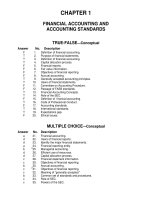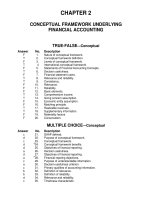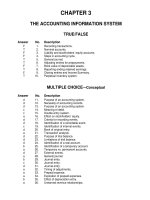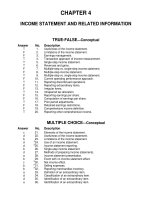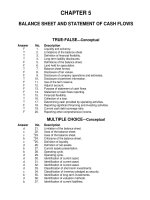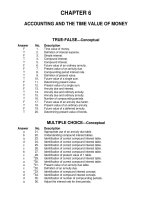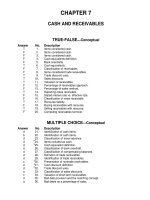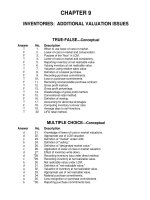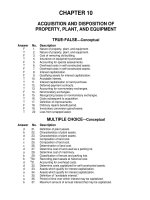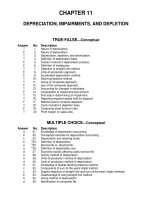Test bank intermediate accounting 14e by kieso chapter 4
Bạn đang xem bản rút gọn của tài liệu. Xem và tải ngay bản đầy đủ của tài liệu tại đây (133.8 KB, 48 trang )
To download more slides, ebook, solutions and test bank, visit
CHAPTER 4
INCOME STATEMENT AND RELATED INFORMATION
IFRS questions are available at the end of this chapter.
TRUE-FALSE—Conceptual
Answer
T
F
F
T
T
T
F
F
T
F
T
F
F
T
F
F
T
F
F
T
No.
Description
1.
2.
3.
4.
5.
6.
7.
8.
9.
10.
11.
12.
13.
14.
15.
16.
17.
18.
19.
20.
Usefulness of the income statement.
Limitations of the income statement.
Earnings management.
Transaction approach of income measurement.
Single-step income statement.
Revenues and gains.
Multiple-step vs. single-step income statement.
Multiple-step income statement.
Multiple-step vs. single-step income statement.
Current operating performance approach.
Reporting discontinued operations.
Reporting extraordinary items.
Irregular items.
Intraperiod tax allocation.
Reporting earnings per share.
Computation of earnings per share.
Prior period adjustments.
Retained earnings restrictions.
Comprehensive income definition.
Reporting other comprehensive income.
MULTIPLE CHOICE—Conceptual
Answer
c
d
b
d
d
c
b
c
b
a
d
b
d
a
b
c
No.
21.
22.
23.
S
24.
S
25.
26.
27.
28.
29.
30.
31.
32.
33.
34.
35.
S
36.
Description
Elements of the income statement.
Usefulness of the income statement.
Limitations of the income statement.
Use of an income statement.
Income statement reporting.
Income statement information.
Example of managing earnings down.
Example of managing earnings up.
Improving current net income.
Decreasing current net income.
Single-step income statement advantage.
Single-step income statement.
Methods of preparing income statements.
Income statement presentation.
Event with no income statement effect.
Net income effect.
To download more slides, ebook, solutions and test bank, visit
Test Bank for Intermediate Accounting, Fourteenth Edition
4-2
MULTIPLE CHOICE—Conceptual (cont.)
Answer
b
b
a
d
d
a
d
a
d
d
c
c
c
d
d
c
d
d
c
d
d
c
d
c
d
d
b
c
b
a
d
c
c
No.
P
37.
38.
39.
40.
41.
42.
43.
44.
45.
46.
47.
48.
S
49.
50.
51.
52.
53.
54.
55.
56.
57.
S
58.
P
59.
60.
61.
62.
63.
64.
65.
66.
67.
68.
69.
P
Description
Selling expenses.
Reporting merchandise inventory.
Definition of an extraordinary item.
Classification of an extraordinary item.
Identification of an extraordinary item.
Identification of an extraordinary item.
Identification of an extraordinary item.
Presentation of unusual or infrequent items.
Identification of a change in accounting principle.
Classification of extraordinary items.
EPS disclosures on income statement.
Reporting discontinued operations.
Reporting unusual or infrequent items.
Intraperiod tax allocation.
Purpose of intraperiod tax allocation.
Intraperiod tax allocation.
Reporting items net of tax.
Reporting items at gross amount.
Earnings per share disclosure.
EPS disclosures on income statement.
EPS disclosures on income statement.
Earnings per share disclosure.
Reporting correction of an error.
Retained earnings statement.
Prior period adjustment.
Identification of a prior period adjustment.
Reporting EPS amounts.
Reporting EPS on financial statements.
Comprehensive income inclusion.
Displaying comprehensive income.
Comprehensive income disclosure method.
Comprehensive income items.
Providing information about components of comprehensive income.
MULTIPLE CHOICE—Computational
Answer
a
c
a
c
c
c
a
a
a
a
c
No.
Description
70.
71.
72.
73.
74.
75.
76.
77.
78.
79.
80.
Calculate total revenues.
Calculate total expenses.
Single-step income statement.
Multiple-step income statement.
Multiple-step income statement.
Calculation of net sales.
Presentation of gain on sale of plant assets.
Extraordinary items.
Extraordinary items.
Calculate income before extraordinary items.
Calculate income before taxes and extraordinary items.
To download more slides, ebook, solutions and test bank, visit
Income Statement and Related Information
MULTIPLE CHOICE—Computational (cont.)
b
a
b
c
c
c
b
a
a
b
d
d
c
c
a
b
c
d
d
d
a
c
c
a
P
S
81.
82.
83.
84.
85.
86.
87.
88.
89.
90.
91.
92.
93.
94.
95.
96.
97.
98.
99.
100.
101.
102.
103.
104.
Calculate extraordinary loss.
Events affecting income from continuing operations.
Calculation of events affecting net income.
Disposal of a major business component.
Tax effect on irregular items.
Tax effect on irregular items.
Calculate income tax expense.
Calculate income tax expense.
Calculate income tax expense.
Calculate earnings per share.
Calculate EPS for extraordinary loss.
Calculate earnings per share.
Earnings per share.
Earnings per share.
Retained earnings statement.
Retained earnings statement.
Retained earnings statement.
Retained earnings statement.
Calculate balance of retained earnings.
Calculate other comprehensive income.
Calculate comprehensive income.
Calculate ending Accumulated Other Comprehensive Income.
Calculate ending Retained Earnings balance.
Calculate total stockholders' equity.
Note: these questions also appear in the Problem-Solving Survival Guide.
Note: these questions also appear in the Study Guide.
MULTIPLE CHOICE—CPA Adapted
Answer
d
a
a
a
d
c
a
b
a
b
No.
105.
106.
107.
108.
109.
110.
111.
112.
113.
114.
Description
Calculate selling expenses.
Calculate general and administrative expenses.
Calculate selling expenses.
Calculate general and administrative expenses.
Calculate cost of goods manufactured.
Calculate income before extraordinary item.
Determine extraordinary loss.
Determine infrequent gains not extraordinary.
Determine infrequent losses not extraordinary.
Identification of prior period adjustment.
4-3
To download more slides, ebook, solutions and test bank, visit
Test Bank for Intermediate Accounting, Fourteenth Edition
4-4
EXERCISES
Item
Description
E4-115
E4-116
E4-117
E4-118
E4-119
E4-120
E4-121
E4-122
E4-123
Definitions.
Terminology.
Income statement disclosures.
Calculate net income from change in stockholders’ equity.
Calculate net income from change in stockholders’ equity.
Income statement classifications.
Income statement relationships.
Multiple-step income statement.
Classification of income and retained earnings statement items.
PROBLEMS
Item
Description
P4-124
P4-125
P4-126
P4-127
P4-128
P4-129
Multiple-step income statement.
Income statement form.
Multiple-step income statement.
Single-step income statement.
Income statement and retained earnings statement.
Irregular items and financial statements.
CHAPTER LEARNING OBJECTIVES
1.
Understand the uses and limitations of an income statement.
2.
Prepare a single-step income statement.
3.
Prepare a multiple-step income statement.
4.
Explain how to report irregular items.
5.
Explain intraperiod tax allocation.
6.
Identify where to report earnings per share information.
7.
Prepare a retained earnings statement.
8.
Explain how to report other comprehensive income.
To download more slides, ebook, solutions and test bank, visit
Income Statement and Related Information
4-5
SUMMARY OF LEARNING OBJECTIVES BY QUESTIONS
Item
Type
Item
Type
Item
1.
2.
3.
TF
TF
TF
4.
21.
22.
TF
MC
MC
5.
6.
TF
TF
31.
32.
MC
MC
7.
8.
9.
33.
TF
TF
TF
MC
34.
35.
S
36.
P
37.
MC
MC
MC
MC
P
10.
11.
12.
13.
39.
40.
TF
TF
TF
TF
MC
MC
41.
42.
43.
44.
45.
46.
MC
MC
MC
MC
MC
MC
47.
48.
S
49.
77.
78.
79.
14.
50.
51.
TF
MC
MC
52.
53.
54.
MC
MC
MC
85.
86.
87.
15.
16.
47.
TF
TF
MC
55.
56.
57.
MC
MC
MC
17.
18.
P
59.
TF
TF
MC
60.
61.
62.
MC
MC
MC
63.
64.
95.
19.
20.
TF
TF
65.
66.
MC
MC
67.
68.
Note:
23.
24.
S
25.
S
70.
71.
38.
73.
74.
75.
S
TF = True-False
MC = Multiple Choice
58.
90.
91.
Type
Item
Type
Item
Learning Objective 1
MC
26. MC
29.
MC
27. MC
30.
MC
28. MC
115.
Learning Objective 2
MC
72. MC
MC
127.
P
Learning Objective 3
MC
76. MC
108.
MC
105. MC
109.
MC
106. MC
110.
MC
107. MC
120.
Learning Objective 4
MC
80. MC
110.
MC
81. MC
111.
MC
82. MC
112.
MC
83. MC
113.
MC
84. MC
115.
MC
108. MC
116.
Learning Objective 5
MC
88. MC
124.
MC
89. MC
125.
MC
116.
E
126.
Learning Objective 6
MC
92. MC
115.
MC
93. MC
124.
MC
94. MC
126.
Learning Objective 7
MC
96. MC
99.
MC
97. MC
114.
MC
98. MC
115.
Learning Objective 8
MC
69. MC
101.
MC
100. MC
102.
E = Exercise
P = Problem
Type
Item
Type
Item
Type
MC
MC
E
116.
117.
118.
E
E
E
119.
E
MC
MC
MC
E
121.
122.
123.
124.
E
E
E
P
126.
128.
P
P
MC
MC
MC
MC
E
E
123.
124.
125.
126.
127.
128.
E
P
P
P
P
P
P
P
P
127.
128.
P
P
E
P
P
127.
128.
P
P
MC
MC
E
116.
123.
127.
E
E
P
128.
P
MC
MC
103.
104.
MC
MC
To download more slides, ebook, solutions and test bank, visit
4-6
Test Bank for Intermediate Accounting, Fourteenth Edition
TRUE-FALSE—Conceptual
1. The income statement is useful for helping to assess the risk or uncertainty of achieving
future cash flows.
2. A strength of the income statement as compared to the balance sheet is that items that
cannot be measured reliably can be reported in the income statement.
3. Earnings management generally makes income statement information more useful for
predicting future earnings and cash flows.
4. The transaction approach of income measurement focuses on the income-related activities
that have occurred during the period.
5. Companies frequently report income tax expense as the last item before net income on a
single-step income statement.
6. Both revenues and gains increase both net income and owners’ equity.
7. Use of a multiple-step income statement will result in the company reporting a higher net
income than if they used a single-step income statement.
8. The primary advantage of the multiple-step format lies in the simplicity of presentation and
the absence of any implication that one type of revenue or expense item has priority over
another.
9. Gross profit and income from operations are reported on a multiple-step but not a singlestep income statement.
10. The accounting profession has adopted a current operating performance approach to
income reporting.
11. Companies report the results of operations of a component of a business that will be
disposed of separately from continuing operations.
12. Gains or losses from exchange or translation of foreign currencies are reported as
extraordinary items.
13. Discontinued operations, extraordinary items, and unusual gains and losses are all reported
net of tax in the income statement.
14. Intraperiod tax allocation relates the income tax expense of the period to the specific items
that give rise to the amount of the tax provision.
15. A company that reports a discontinued operation or an extraordinary item has the option of
reporting per share amounts for these items.
16. Dividends declared on common and preferred stock are subtracted from net income in the
computation of earnings per share.
To download more slides, ebook, solutions and test bank, visit
Income Statement and Related Information
4-7
17. Prior period adjustments can either be added or subtracted in the Retained Earnings
Statement.
18. Companies only restrict retained earnings to comply with contractual requirements or
current necessity.
19. Comprehensive income includes all changes in equity during a period except those
resulting from distributions to owners.
20. The components of other comprehensive income can be reported in a statement of
stockholders’ equity.
True False Answers—Conceptual
Item
1.
2.
3.
4.
5.
Ans.
T
F
F
T
T
Item
6.
7.
8.
9.
10.
Ans.
T
F
F
T
F
Item
11.
12.
13.
14.
15.
Ans.
T
F
F
T
F
Item
16.
17.
18.
19.
20.
Ans.
F
T
F
F
T
MULTIPLE CHOICE—Conceptual
21.
The major elements of the income statement are
a. revenue, cost of goods sold, selling expenses, and general expense.
b. operating section, nonoperating section, discontinued operations, extraordinary items,
and cumulative effect.
c. revenues, expenses, gains, and losses.
d. all of these.
22.
Information in the income statement helps users to
a. evaluate the past performance of the enterprise.
b. provide a basis for predicting future performance.
c. help assess the risk or uncertainty of achieving future cash flows.
d. all of these.
23.
Limitations of the income statement include all of the following except
a. items that cannot be measured reliably are not reported.
b. only actual amounts are reported in determining net income.
c. income measurement involves judgment.
d. income numbers are affected by the accounting methods employed.
S
24.
Which of the following would represent the least likely use of an income statement
prepared for a business enterprise?
a. Use by customers to determine a company's ability to provide needed goods and
services.
b. Use by labor unions to examine earnings closely as a basis for salary discussions.
c. Use by government agencies to formulate tax and economic policy.
d. Use by investors interested in the financial position of the entity.
To download more slides, ebook, solutions and test bank, visit
4-8
S
Test Bank for Intermediate Accounting, Fourteenth Edition
25.
The income statement reveals
a. resources and equities of a firm at a point in time.
b. resources and equities of a firm for a period of time.
c. net earnings (net income) of a firm at a point in time.
d. net earnings (net income) of a firm for a period of time.
26.
The income statement information would help in which of the following tasks?
a. Evaluate the liquidity of a company.
b. Evaluate the solvency of a company
c. Estimate future cash flows
d. Estimate future financial flexibility
27.
Which of the following is an example of managing earnings down?
a. Changing estimated bad debts from 3 percent to 2.5 percent of sales.
b. Revising the estimated life of equipment from 10 years to 8 years.
c. Not writing off obsolete inventory.
d. Reducing research and development expenditures.
28.
Which of the following is an example of managing earnings up?
a. Decreasing estimated salvage value of equipment.
b. Writing off obsolete inventory.
c. Underestimating warranty claims.
d. Accruing a contingent liability for an ongoing lawsuit.
29.
What might a manager do during the last quarter of a fiscal year if she wanted to improve
current annual net income?
a. Increase research and development activities.
b. Relax credit policies for customers.
c. Delay shipments to customers until after the end of the fiscal year.
d. Delay purchases from suppliers until after the end of the fiscal year.
30.
What might a manager do during the last quarter of a fiscal year if she wanted to decrease
current annual net income?
a. Delay shipments to customers until after the end of the fiscal year.
b. Relax credit policies for customers.
c. Pay suppliers all amounts owed.
d. Delay purchases from suppliers until after the end of the fiscal year.
31.
Which of the following is an advantage of the single-step income statement over the
multiple-step income statement?
a. It reports gross profit for the year.
b. Expenses are classified by function.
c. It matches costs and expenses with related revenues.
d. It does not imply that one type of revenue or expense has priority over another.
32.
The single-step income statement emphasizes
a. the gross profit figure.
b. total revenues and total expenses.
c. extraordinary items and accounting changes more than these are emphasized in the
multiple-step income statement.
d. the various components of income from continuing operations.
To download more slides, ebook, solutions and test bank, visit
Income Statement and Related Information
4-9
33.
Which of the following is an acceptable method of presenting the income statement?
a. A single-step income statement
b. A multiple-step income statement
c. A consolidated statement of income
d. All of these
34.
Which of the following is not a generally practiced method of presenting the income
statement?
a. Including prior period adjustments in determining net income
b. The single-step income statement
c. The consolidated statement of income
d. Including gains and losses from discontinued operations of a component of a business
in determining net income
35.
The occurrence which most likely would have no effect on 2012 net income (assuming
that all amounts involved are material) is the
a. sale in 2012 of an office building contributed by a stockholder in 1983.
b. collection in 2012 of a receivable from a customer whose account was written off in
2011 by a charge to the allowance account.
c. settlement based on litigation in 2012 of previously unrecognized damages from a
serious accident which occurred in 2010.
d. worthlessness determined in 2012 of stock purchased on a speculative basis in 2008.
36.
The occurrence that most likely would have no effect on 2012 net income is the
a. sale in 2012 of an office building contributed by a stockholder in 1961.
b. collection in 2012 of a dividend from an investment.
c. correction of an error in the financial statements of a prior period discovered
subsequent to their issuance.
d. stock purchased in 1996 deemed worthless in 2012.
S
P
37. Which of the following is not a selling expense?
a. Advertising expense
b. Office salaries expense
c. Freight-out
d. Store supplies consumed
P
38.
The accountant for the Lintz Sales Company is preparing the income statement for 2012
and the balance sheet at December 31, 2012. The January 1, 2012 merchandise
inventory balance will appear
a. only as an asset on the balance sheet.
b. only in the cost of goods sold section of the income statement.
c. as a deduction in the cost of goods sold section of the income statement and as a
current asset on the balance sheet.
d. as an addition in the cost of goods sold section of the income statement and as a
current asset on the balance sheet.
39.
In order to be classified as an extraordinary item in the income statement, an event or
transaction should be
a. unusual in nature, infrequent, and material in amount.
b. unusual in nature and infrequent, but it need not be material.
c. infrequent and material in amount, but it need not be unusual in nature.
d. unusual in nature and material, but it need not be infrequent.
To download more slides, ebook, solutions and test bank, visit
4 - 10
Test Bank for Intermediate Accounting, Fourteenth Edition
40.
Classification as an extraordinary item on the income statement would be appropriate for
the
a. gain or loss on disposal of a component of the business.
b. substantial write-off of obsolete inventories.
c. loss from a strike.
d. none of these.
41.
Which of these is generally an example of an extraordinary item?
a. Loss incurred because of a strike by employees.
b. Write-off of deferred marketing costs believed to have no future benefit.
c. Gain resulting from the devaluation of the U.S. dollar.
d. Gain resulting from the state exercising its right of eminent domain on a piece of land
used as a parking lot.
42.
Under which of the following conditions would material flood damage be considered an
extraordinary item for financial reporting purposes?
a. Only if floods in the geographical area are unusual in nature and occur infrequently.
b. Only if the flood damage is material in amount and could have been reduced by
prudent management.
c. Under any circumstances as an extraordinary item.
d. Flood damage should never be classified as an extraordinary item.
43.
An item that should be classified as an extraordinary item is
a. write-off of goodwill.
b. gains from transactions involving foreign currencies.
c. losses from moving a plant to another city.
d. gains from a company selling the only investment it has ever owned.
44.
How should an unusual event not meeting the criteria for an extraordinary item be
disclosed in the financial statements?
a. Shown as a separate item in operating revenues or expenses if material and supplemented by a footnote if deemed appropriate.
b. Shown in operating revenues or expenses if material but not shown as a separate item.
c. Shown net of income tax after ordinary net earnings but before extraordinary items.
d. Shown net of income tax after extraordinary items but before net earnings.
45.
Which of the following is a change in accounting principle?
a. A change in the estimated service life of machinery
b. A change from FIFO to LIFO
c. A change from straight-line to double-declining-balance
d. A change from FIFO to LIFO and a change from straight-line to double-decliningbalance
46.
Which of the following is never classified as an extraordinary item?
a. Losses from a major casualty.
b. Losses from an expropriation of assets.
c. Gain on a sale of the only security investment a company has ever owned.
d. Losses from exchange or translation of foreign currencies.
To download more slides, ebook, solutions and test bank, visit
Income Statement and Related Information
4 - 11
47.
Which of the following is a required disclosure in the income statement when reporting the
disposal of a component of the business?
a. The gain or loss on disposal should be reported as an extraordinary item.
b. Results of operations of a discontinued component should be disclosed immediately
below extraordinary items.
c. Earnings per share from both continuing operations and net income should be
disclosed on the face of the income statement.
d. The gain or loss on disposal should not be segregated, but should be reported together
with the results of continuing operations.
48.
When a company discontinues an operation and disposes of the discontinued operation
(component), the transaction should be included in the income statement as a gain or loss
on disposal reported as
a. a prior period adjustment.
b. an extraordinary item.
c. an amount after continuing operations and before extraordinary items.
d. a bulk sale of plant assets included in income from continuing operations.
S
49.
A material item which is unusual in nature or infrequent in occurrence, but not both should
be shown in the income statement
a.
b.
c.
d.
Net of Tax
No
Yes
No
Yes
Disclosed Separately
No
Yes
Yes
No
50.
Income taxes are allocated to
a. extraordinary items.
b. discontinued operations.
c. prior period adjustments.
d. all of these.
51.
Which of the following is true about intraperiod tax allocation?
a. It arises because certain revenue and expense items appear in the income statement
either before or after they are included in the tax return.
b. It is required for extraordinary items and cumulative effect of accounting changes but
not for prior period adjustments.
c. Its purpose is to allocate income tax expense evenly over a number of accounting
periods.
d. Its purpose is to relate the income tax expense to the items which affect the amount of
tax.
52.
Companies use intraperiod tax allocation for all of the following items except
a. Discontinued operations.
b. Extraordinary items.
c. Changes in accounting estimates.
d. Income from continuing operations.
To download more slides, ebook, solutions and test bank, visit
4 - 12
Test Bank for Intermediate Accounting, Fourteenth Edition
53.
Which of the following items would be reported net of tax on the face of the income
statement?
a. Prior period adjustment
b. Unusual gain
c. Cumulative effect of a change in an accounting principle
d. Discontinued operations
54.
Which of the following items would be reported at its gross amount on the face of the
income statement?
a. Extraordinary loss
b. Prior period adjustment
c. Cumulative effect of a change in an accounting principle
d. Unusual gain
55.
Where must earnings per share be disclosed in the financial statements to satisfy
generally accepted accounting principles?
a. On the face of the statement of retained earnings (or, statement of stockholders'
equity.)
b. In the footnotes to the financial statements.
c. On the face of the income statement.
d. Either (a) or (c).
56.
Which of the following earnings per share figures must be disclosed on the face of the
income statement?
a. EPS on income from continuing operations.
b. The effect on EPS from operations of a discontinued division, net of taxes.
c. The effect on EPS from an extraordinary item, net of taxes.
d. All of the above.
57.
Which of the following earnings per share figures must be disclosed on the face of the
income statement?
a. EPS for income before taxes.
b. The effect on EPS from unusual items.
c. EPS for gross profit.
d. EPS for income from continuing operations.
S
Earnings per share should always be shown separately for
a. net income and gross margin.
b. net income and pretax income.
c. income before extraordinary items.
d. extraordinary items and prior period adjustments.
P
A correction of an error in prior periods' income will be reported
58.
59.
a.
b.
c.
d.
In the income statement
Yes
No
Yes
No
Net of tax
Yes
No
No
Yes
To download more slides, ebook, solutions and test bank, visit
Income Statement and Related Information
4 - 13
60.
Which of the following items will not appear in the retained earnings statement?
a. Net loss
b. Prior period adjustment
c. Discontinued operations
d. Dividends
61.
Which one of the following types of losses is excluded from the determination of net
income in income statements?
a. Material losses resulting from transactions in the company's investments account.
b. Material losses resulting from unusual sales of assets not acquired for resale.
c. Material losses resulting from the write-off of intangibles.
d. Material losses resulting from correction of errors related to prior periods.
62.
Watts Corporation made a very large arithmetical error in the preparation of its year-end
financial statements by improper placement of a decimal point in the calculation of
depreciation. The error caused the net income to be reported at almost double the proper
amount. Correction of the error when discovered in the next year should be treated as
a. an increase in depreciation expense for the year in which the error is discovered.
b. a component of income for the year in which the error is discovered, but separately
listed on the income statement and fully explained in a note to the financial
statements.
c. an extraordinary item for the year in which the error was made.
d. a prior period adjustment.
63.
A company is not required to report a per share amount on the face of the income
statement for which of the following items?
a. Net income
b. Prior period adjustment
c. Extraordinary item
d. Discontinued operations
64.
Earnings per share data are required on the face of which of the following financial
statements?
a. Statement of retained earnings
b. Statement of stockholders' equity
c. Income statement
d. Balance sheet
65.
Which of the following is included in comprehensive income?
a. Investments by owners.
b. Unrealized gains on available-for-sale securities.
c. Distributions to owners.
d. Changes in accounting principles.
66.
Which of the following is not an acceptable way of displaying the components of other
comprehensive income?
a. Combined statement of retained earnings
b. Second income statement
c. Combined statement of comprehensive income
d. As part of the statement of stockholders' equity
To download more slides, ebook, solutions and test bank, visit
4 - 14
Test Bank for Intermediate Accounting, Fourteenth Edition
67.
Which disclosure method do most companies use to display the components of other
comprehensive income?
a. Combined statement of retained earnings
b. Second income statement
c. Combined statement of comprehensive income
d. As part of the statement of stockholders' equity
68.
Comprehensive income includes all of the following except
a. dividend revenue.
b. losses on disposal of assets.
c. investments by owners.
d. unrealized holding gains.
69.
The approach most companies use to provide information related to the components of
other comprehensive income is a
a. second separate income statement.
b. combined income statement of comprehensive income.
c. separate column in the statement of changes in stockholders’ equity.
d. footnote disclosure.
Multiple Choice Answers—Conceptual
Item
21.
22.
23.
24.
25.
26.
27.
Ans.
c
d
d
d
d
c
b
Item
28.
29.
30.
31.
32.
33.
34.
Ans.
c
b
a
d
b
d
a
Item
35.
36.
37.
38.
39.
40.
41.
Ans.
b
c
b
b
a
d
d
Item
42.
43.
44.
45.
46.
47.
48.
Ans.
a
d
a
d
d
c
c
Item
49.
50.
51.
52.
53.
54.
55.
Ans.
Item
Ans.
Item
Ans.
c
d
d
c
d
d
c
56.
57.
58.
59.
60.
61.
62.
d
d
c
d
c
d
d
63.
64.
65.
66.
67.
68.
69.
b
c
b
a
d
c
c
Solution to Multiple Choice question for which the answer is “none of these.”
40. Many answers are possible.
To download more slides, ebook, solutions and test bank, visit
Income Statement and Related Information
MULTIPLE CHOICE—Computational
70.
Ortiz Co. had the following account balances:
Sales revenue
$ 180,000
Cost of goods sold
90,000
Salaries and wages expense
15,000
Depreciation expense
30,000
Dividend revenue
6,000
Utilities expense
12,000
Rent revenue
30,000
Interest expense
18,000
Sales returns and allow.
16,500
Advertising expense
19,500
What would Ortiz report as total revenues in a single-step income statement?
a.
b.
c.
d.
71.
$199,500
$ 15,000
$216,000
$180,000
Ortiz Co. had the following account balances:
Sales revenue
$ 180,000
Cost of goods sold
90,000
Salaries and wages expense
15,000
Depreciation expense
30,000
Dividend revenue
6,000
Utilities expense
12,000
Rent revenue
30,000
Interest expense
18,000
Sales returns and allow.
16,500
Advertising expense
19,500
What would Ortiz report as total expenses in a single-step income statement?
a.
b.
c.
d.
72.
$190,500
$201,000
$184,500
$ 94,500
For Mortenson Company, the following information is available:
Cost of goods sold
Dividend revenue
Income tax expense
Operating expenses
Sales revenue
$120,000
5,000
12,000
46,000
200,000
In Mortenson’s single-step income statement, gross profit
a. should not be reported.
b. should be reported at $27,000.
c. should be reported at $80,000.
d. should be reported at $85,000.
4 - 15
To download more slides, ebook, solutions and test bank, visit
4 - 16
73.
Test Bank for Intermediate Accounting, Fourteenth Edition
For Mortenson Company, the following information is available:
Cost of goods sold
Dividend revenue
Income tax expense
Operating expenses
Sales revenue
$120,000
5,000
12,000
46,000
200,000
In Mortenson’s multiple-step income statement, gross profit
a. should not be reported
b. should be reported at $27,000.
c. should be reported at $80,000.
d. should be reported at $85,000.
74.
For Rondelli Company, the following information is available:
Cost of goods sold
Dividend revenue
Income tax expense
Operating expenses
Sales revenue
$270,000
12,000
27,000
105,000
450,000
In Rondelli's multiple-step income statement, gross profit
a. should not be reported
b. should be reported at $60,000.
c. should be reported at $180,000.
d. should be reported at $192,000.
75.
Gross billings for merchandise sold by Lang Company to its customers last year
amounted to $12,720,000; sales returns and allowances were $370,000, sales discounts
were $175,000, and freight-out was $140,000. Net sales last year for Lang Company were
a. $12,720,000.
b. $12,350,000.
c. $12,175,000.
d. $12,035,000.
76.
If plant assets of a manufacturing company are sold at a gain of $1,640,000 less related
taxes of $500,000, and the gain is not considered unusual or infrequent, the income
statement for the period would disclose these effects as
a. a gain of $1,640,000 and an increase in income tax expense of $500,000.
b. operating income net of applicable taxes, $1,140,000.
c. a prior period adjustment net of applicable taxes, $1,140,000.
d. an extraordinary item net of applicable taxes, $1,140,000.
77.
Manning Company has the following items: write-down of inventories, $360,000; loss on
disposal of Sports Division, $555,000; and loss due to strike, $339,000. Ignoring income
taxes, what total amount should Manning Company report as extraordinary losses?
a. $ -0-.
b. $555,000.
c. $699,000.
d. $894,000.
To download more slides, ebook, solutions and test bank, visit
Income Statement and Related Information
4 - 17
78.
Garwood Company has the following items: write-down of inventories, $360,000; loss on
disposal of Sports Division, $555,000; and loss due to an expropriation, $339,000.
Ignoring income taxes, what total amount should Garwood Company report as
extraordinary losses?
a. $339,000
b. $555,000.
c. $699,000.
d. $894,000.
79.
An income statement shows “income before income taxes and extraordinary items” in the
amount of $2,740,000. The income taxes payable for the year are $1,440,000, including
$480,000 that is applicable to an extraordinary gain. Thus, the “income before
extraordinary items” is
a. $1,780,000.
b. $820,000.
c. $1,860,000.
d. $900,000.
80.
Dole Company, with an applicable income tax rate of 30%, reported net income of
$350,000. Included in income for the period was an extraordinary loss from flood damage
of $50,000 before deducting the related tax effect. The company's income before income
taxes and extraordinary items was
a. $400,000.
b. $500,000.
c. $550,000.
d. $385,000.
81.
A review of the December 31, 2012, financial statements of Somer Corporation revealed
that under the caption "extraordinary losses," Somer reported a total of $1,030,000.
Further analysis revealed that the $1,030,000 in losses was comprised of the following
items:
(1) Somer recorded a loss of $300,000 incurred in the abandonment of equipment
formerly used in the business.
(2) In an unusual and infrequent occurrence, a loss of $500,000 was sustained as a
result of hurricane damage to a warehouse.
(3) During 2012, several factories were shut down during a major strike by employees,
resulting in a loss of $170,000.
(4) Uncollectible accounts receivable of $60,000 were written off as uncollectible.
Ignoring income taxes, what amount of loss should Somer report as extraordinary on its
2012 income statement?
a. $300,000.
b. $500,000.
c. $800,000.
d. $1,030,000.
To download more slides, ebook, solutions and test bank, visit
4 - 18
Test Bank for Intermediate Accounting, Fourteenth Edition
82. At Ruth Company, events and transactions during 2012 included the following. The tax rate
for all items is 30%.
(1) Depreciation for 2010 was found to be understated by $60,000.
(2) A strike by the employees of a supplier resulted in a loss of $50,000.
(3) The inventory at December 31, 2010 was overstated by $80,000.
(4) A flood destroyed a building that had a book value of $1,000,000. Floods are very
uncommon in that area.
The effect of these events and transactions on 2012 income from continuing operations
net of tax would be
a. ($35,000).
b. ($77,000).
c. ($133,000).
d. ($833,000).
83. At Ruth Company, events and transactions during 2012 included the following. The tax rate
for all items is 30%.
(1) Depreciation for 2010 was found to be understated by $60,000.
(2) A strike by the employees of a supplier resulted in a loss of $50,000.
(3) The inventory at December 31, 2010 was overstated by $80,000.
(4) A flood destroyed a building that had a book value of $1,000,000. Floods are very
uncommon in that area.
The effect of these events and transactions on 2012 net income net of tax would be
a. ($35,000).
b. ($735,000).
c. ($777,000).
d. ($833,000).
84.
During 2012, Lopez Corporation disposed of Pine Division, a major component of its
business. Lopez realized a gain of $1,800,000, net of taxes, on the sale of Pine's assets.
Pine's operating losses, net of taxes, were $2,100,000 in 2012. How should these facts be
reported in Lopez's income statement for 2012?
a.
b.
c.
d.
85.
Total Amount to be Included in
Income from
Results of
Continuing Operations
Discontinued Operations
$2,100,000 loss
$1,800,000 gain
300,000 loss
0
0
300,000 loss
1,800,000 gain
2,100,000 loss
Sandstrom Corporation has an extraordinary loss of $150,000, an unusual gain of
$105,000, and a tax rate of 40%. At what amount should Sandstrom report each item?
a.
b.
c.
d.
Extraordinary loss
$(150,000)
(150,000)
(90,000)
(90,000)
Unusual gain
$105,000
63,000
105,000
63,000
To download more slides, ebook, solutions and test bank, visit
Income Statement and Related Information
86.
Prophet Corporation has an extraordinary loss of $600,000, an unusual gain of $420,000,
and a tax rate of 40%. At what amount should Prophet report each item?
a.
b.
c.
d.
87.
4 - 19
Extraordinary loss
$(600,000)
(600,000)
(360,000)
(360,000)
Unusual gain
$420,000
252,000
420,000
252,000
Arreaga Corp. has a tax rate of 40 percent and income before non-operating items of
$464,000. It also has the following items (gross amounts).
Unusual loss
Extraordinary loss
Gain on disposal of equipment
Change in accounting principle
increasing prior year's income
$ 74,000
202,000
16,000
106,000
What is the amount of income tax expense Arreaga would report on its income statement?
a. $185,600
b. $162,400
c. $198,400
d. $124,000
88.
Palomo Corp has a tax rate of 30 percent and income before non-operating items of
$714,000. It also has the following items (gross amounts).
Unusual gain
Loss from discontinued operations
Dividend revenue
Income increasing prior
period adjustment
$ 46,000
366,000
12,000
148,000
What is the amount of income tax expense Palomo would report on its income statement?
a. $231,600
b. $121,800
c. $166,200
d. $217,800
89.
Lantos Company had a 40 percent tax rate. Given the following pre-tax amounts, what
would be the income tax expense reported on the face of the income statement?
Sales revenue
$ 300,000
Cost of goods sold
180,000
Salaries and wages expense
24,000
Depreciation expense
33,000
Dividend revenue
27,000
Utilities expense
3,000
Extraordinary loss
30,000
Interest expense
6,000
a.
b.
c.
d.
$32,400
$20,400
$21,600
$ 9,600
To download more slides, ebook, solutions and test bank, visit
4 - 20
90.
Test Bank for Intermediate Accounting, Fourteenth Edition
In 2012, Esther Corporation reported net income of $600,000. It declared and paid
preferred stock dividends of $150,000 and common stock dividends of $60,000. During
2012, Esther had a weighted average of 200,000 common shares outstanding. Compute
Esther's 2012 earnings per share.
a.
b.
c.
d.
91.
In 2012, Linz Corporation reported an extraordinary loss of $1,000,000, net of tax. It
declared and paid preferred stock dividends of $100,000 and common stock dividends of
$300,000. During 2012, Linz had a weighted average of 400,000 common shares
outstanding. Compute the effect of the extraordinary loss, net of tax, on earnings per share.
a.
b.
c.
d.
92.
$1.50
$1.75
$2.25
$2.50
In 2012, Benfer Corporation reported net income of $280,000. It declared and paid
common stock dividends of $32,000 and had a weighted average of 70,000 common
shares outstanding. Compute the earnings per share to the nearest cent.
a.
b.
c.
d.
93.
$1.95
$2.25
$3.00
$3.75
$3.54
$2.80
$3.60
$4.00
Benedict Corporation reports the following information:
Net income
Dividends on common stock
Dividends on preferred stock
Weighted average common shares outstanding
$750,000
210,000
90,000
100,000
Benedict should report earnings per share of
a. $4.50.
b. $5.40
c. $6.60.
d. $7.50.
94.
Norling Corporation reports the following information:
Net income
Dividends on common stock
Dividends on preferred stock
Weighted average common shares outstanding
Norling should report earnings per share of
a. $2.25.
b. $2.70
c. $3.30.
d. $3.75.
$750,000
210,000
90,000
200,000
To download more slides, ebook, solutions and test bank, visit
Income Statement and Related Information
95.
Moorman Corporation reports the following information:
Correction of understatement of depreciation expense
in prior years, net of tax
$ 645,000
Dividends declared
480,000
Net income
1,500,000
Retained earnings, 1/1/12, as reported
3,000,000
Moorman should report retained earnings, 1/1/12, as adjusted at
a. $2,355,000.
b. $3,000,000.
c. $3,645,000.
d. $4,665,000.
96.
Moorman Corporation reports the following information:
Correction of understatement of depreciation expense
in prior years, net of tax
$ 645,000
Dividends declared
480,000
Net income
1,500,000
Retained earnings, 1/1/12, as reported
3,000,000
Moorman should report retained earnings, 12/31/12, as adjusted at
a. $2,355,000.
b. $3,375,000.
c. $4,020,000.
d. $4,665,000.
97.
Leonard Corporation reports the following information:
Correction of overstatement of depreciation expense
in prior years, net of tax
$ 215,000
Dividends declared
160,000
Net income
500,000
Retained earnings, 1/1/12, as reported
2,000,000
Leonard should report retained earnings, 1/1/12, as adjusted at
a. $1,785,000.
b. $2,000,000.
c. $2,215,000.
d. $2,555,000.
98.
Leonard Corporation reports the following information:
Correction of overstatement of depreciation expense
in prior years, net of tax
$ 215,000
Dividends declared
160,000
Net income
500,000
Retained earnings, 1/1/12, as reported
2,000,000
Leonard should report retained earnings, 12/31/12, at
a. $1,785,000.
b. $2,125,000.
c. $2,340,000.
d. $2,555,000.
4 - 21
To download more slides, ebook, solutions and test bank, visit
4 - 22
99.
Test Bank for Intermediate Accounting, Fourteenth Edition
The following information was extracted from the accounts of Essex Corporation at
December 31, 2012:
CR(DR)
Total reported income since incorporation
$3,400,000
Total cash dividends paid
(1,600,000)
Unrealized holding loss
(240,000)
Total stock dividends distributed
(400,000)
Prior period adjustment, recorded January 1, 2012
150,000
What should be the balance of retained earnings at December 31, 2012?
a. $1,310,000.
b. $1,400,000.
c. $1,160,000.
d. $1,550,000.
100.
Madsen Company reported the following information for 2012:
Sales revenue
Cost of goods sold
Operating expenses
Unrealized holding gain on available-for-sale securities
Cash dividends received on the securities
$1,530,000
1,050,000
165,000
120,000
6,000
For 2012, Madsen would report other comprehensive income of
a. $411,000.
b. $405,000.
c. $126,000.
d. $120,000.
101.
Korte Company reported the following information for 2012:
Sales revenue
Cost of goods sold
Operating expenses
Unrealized holding gain on available-for-sale securities
Cash dividends received on the securities
For 2012, Korte would report comprehensive income of
a. $351,000.
b. $345,000.
c. $291,000.
d. $60,000.
$1,500,000
1,050,000
165,000
60,000
6,000
To download more slides, ebook, solutions and test bank, visit
Income Statement and Related Information
102.
For the year ended December 31, 2012, Transformers Inc. reported the following:
Net income
Preferred dividends declared
Common dividend declared
Unrealized holding loss, net of tax
Retained earnings
Common stock
Accumulated Other Comprehensive Income,
Beginning Balance
$120,000
20,000
4,000
2,000
160,000
80,000
10,000
What would Transformers report as its ending balance of Accumulated Other
Comprehensive Income?
a.
b.
c.
d.
103.
$12,000
$10,000
$8,000
$2,000
For the year ended December 31, 2012, Transformers Inc. reported the following:
Net income
$120,000
Preferred dividends declared
20,000
Common dividend declared
4,000
Unrealized holding loss, net of tax
2,000
Retained earnings, beginning balance
160,000
Common stock
80,000
Accumulated Other Comprehensive Income,
Beginning Balance
10,000
What would Transformers report as the ending balance of Retained Earnings?
a.
b.
c.
d.
104.
$278,000
$266,000
$256,000
$254,000
For the year ended December 31, 2012, Transformers Inc. reported the following:
Net income
$120,000
Preferred dividends declared
20,000
Common dividend declared
4,000
Unrealized holding loss, net of tax
2,000
Retained earnings, beginning balance
160,000
Common stock
80,000
Accumulated Other Comprehensive Income,
Beginning Balance
10,000
What would Transformers report as total stockholders' equity?
a.
b.
c.
d.
$344,000
$336,000
$256,000
$240,000
4 - 23
To download more slides, ebook, solutions and test bank, visit
Test Bank for Intermediate Accounting, Fourteenth Edition
4 - 24
Multiple Choice Answers—Computational
Item
Ans.
70.
71.
72.
73.
74.
75.
a
c
a
c
c
c
Item
76.
77.
78.
79.
80.
81.
Ans.
a
a
a
a
c
b
Item
82.
83.
84.
85.
86.
87.
Ans.
a
b
c
c
c
b
Item
88.
89.
90.
91.
92.
93.
Ans.
Item
Ans.
Item
Ans.
a
a
b
d
d
c
94.
95.
96.
97.
98.
99.
c
a
b
c
d
d
100.
101
102
103
104
d
a
c
c
a
MULTIPLE CHOICE—CPA Adapted
105. Perry Corp. reports operating expenses in two categories: (1) selling and (2) general and
administrative. The adjusted trial balance at December 31, 2012, included the following
expense accounts:
Accounting and legal fees
Advertising
Freight-out
Interest
Loss on sale of long-term investments
Officers' salaries
Rent for office space
Sales salaries and commissions
$280,000
240,000
150,000
120,000
60,000
360,000
360,000
220,000
One-half of the rented premises is occupied by the sales department.
How much of the expenses listed above should be included in Perry's selling expenses for
2012?
a. $460,000.
b. $610,000.
c. $640,000.
d. $790,000.
106. Perry Corp. reports operating expenses in two categories: (1) selling and (2) general and
administrative. The adjusted trial balance at December 31, 2012, included the following
expense accounts:
Accounting and legal fees
Advertising
Freight-out
Interest
Loss on sale of long-term investments
Officers' salaries
Rent for office space
Sales salaries and commissions
$280,000
240,000
150,000
120,000
60,000
360,000
360,000
220,000
One-half of the rented premises is occupied by the sales department.
To download more slides, ebook, solutions and test bank, visit
Income Statement and Related Information
4 - 25
How much of the expenses listed above should be included in Perry's general and
administrative expenses for 2012?
a. $820,000.
b. $880,000.
c. $940,000.
d. $1,000,000.
107.
Didde Corp. reports operating expenses in two categories: (1) selling and (2) general and
administrative. The adjusted trial balance at December 31, 2012 included the following
expense and loss accounts:
Accounting and legal fees
Advertising
Freight-out
Interest
Loss on sale of long-term investment
Officers' salaries
Rent for office space
Sales salaries and commissions
$210,000
270,000
120,000
105,000
45,000
335,000
330,000
255,000
One-half of the rented premises is occupied by the sales department. Didde's total selling
expenses for 2012 are
a. $810,000.
b. $690,000.
c. $645,000.
d. $555,000.
108.
The following items were among those that were reported on Dye Co.'s income statement
for the year ended December 31, 2012:
Legal and audit fees
$390,000
Rent for office space
540,000
Interest on inventory floor plan
630,000
Loss on abandoned equipment used in operations
105,000
The office space is used equally by Dye's sales and accounting departments. What
amount of the above-listed items should be classified as general and administrative
expenses in Dye's multiple-step income statement?
a. $660,000.
b. $765,000.
c. $930,000.
d. $1,290,000.
109. Logan Corp.'s trial balance of income statement accounts for the year ended December 31,
2012 included the following:
Debit
Credit
Sales revenue
$280,000
Cost of goods sold
$100,000
Administrative expenses
50,000
Loss on disposal of equipment
18,000
Sales commission expense
16,000
Interest revenue
10,000
Freight-out
6,000
